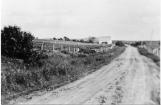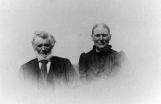1
War service: a view of some of those who served during time of war. Others served but we do not have a pictorial record.3
A stake by the road - by Barrie FraserTravel on the Scotsville-Lake Ainslie road in the early 1900's was still by horse and buggy. In those years the road was narrow and gravel, and brand new iron bridges spanned the Margaree at Scotsville, and Trout River. The five young men in this story were all born in the 1890's and grew up on small farms in Scotsville and Lake Ainslie, and like thousands of other young Canadians went overseas to fight in World War. They didn't return home. The steeple of the East Lake Ainslie Presbyterian Church was built to honour their memory.
5
About a quarter mile west of Scotsville you arrive at the farm where Dan MacGregor lived with his parents and seven brothers and sisters. Today, his niece and nephew, Annie and Chris MacGregor, live on the farm. Dan was born Jan. 20, 1890. His parents were John and Annie (Robertson) MacGregor. He attended a one room school on the hill above the Scotsville bridge. Later he went to Pictou Academy for his grade twelve. He became a school teacher and moved out West where he taught in Eastwood, Saskatchewan. He also lived in Atwater, Sask.Out West Dan got to know his Robertson cousins who had moved there earlier . "One day", his niece, Annie , says "he was going up the street. This man was coming with a double team of horses. Dan stepped out on the street and grabbed one of the horse halters to stop the man. He said, 'You got to be related to me, you look so much like my Uncle Neil.' The man turned out to be his first cousin."
Dan enlisted out West. He belonged to the Canadian Infantry (Central Ontario Regiment, 102 Battalion). In October of 1916 he came home to Scotsville for his embarkation leave. Judging from a letter he later wrote to his sister, Mary, he left home for overseas on Saturday, Oct. 27.
Before leaving he removed the braid from his uniform and hung it on an upstairs bureau. Much to his family's credit it still hangs there.
6
John Grant MacKay, seated, was born in Scotsville, Nova Scotia and died in Montreal of TB.1915
unknown

7
Continuing on from the MacGregor farm you go down the hill and cross the bridge. At the crossroads, a couple of hundred feet from the bridge, you turn right and head up the lake. About a quarter mile you arrive at the farm where John Grant MacKay lived with his parents and his nine brothers and sisters.Being born Feb. 20, 1890 John Grant was just a month younger than Dan MacGregor, and the two would have grown up together in Scotsville. John Grant's parents were John (Iain Iain Rouadh) and Kate (MacLean) MacKay. When John Grant was 17 both his parents died, only a month between them. The MacKay family home still stands, and is next door to Buck Campbell's.
John Grant enlisted in the First Quebec Regiment where he was Private, number 3081960.
9
About four miles up from John Grant's you arrive at Morris MacLean's. He, too, came from a large family, having nine brothers and sisters. He was born May 4, 1892. His parents were Allan (Ailean Iain) and Sarah (MacFayden) MacLean. In recent times Morris's brother Howard lived on the family farm.Morris was a boyhood friend of Charlie (CRF) MacLennan who was raised by his grandparents at Charles Neil MacLean's. The two boys would walk to school together. If Morris would leave early he would put a stake out by the road to let Charlie know he had
already gone.
Morris's nephew, Donald MacMillan, who lives in Halifax, remembers hearing that his uncle was talented in art. "He was a natural cartoonist," Donald says, "He could take a pencil and quickly draw a likeness of a person that was instantly recognizable."
11
About two miles up the road from Morris's you arrive at Malcolm MacKay's. In the household were Malcolm's parents and his eight brothers and sisters.Malcolm was born Sept. 22, 1895. His parents were Donald (Domhnull Chaluim) and
Maggie (Cameron) MacKay. Tragedy befell the family in 1908 when Maggie died during
childbirth. Malcolm's sister, Annie, then about 18, look over her mother's duties of raising
here younger brothers and sisters. But managing the household was difficult and the family struggled.
Malcolm and his brothers would dive from the top of the Trout River bridge. His brother, Johnny, is especially remembered for his ability to swim.
Malcolm enlisted with the Nova Scotia Regiment of the Canadian Infantry, Service Number 222611.
Charles Neil MacLean, who went to school with some of the younger MacKays remembers Malcolm visiting the school while home on embarkation leave. "He was in uniform," Charles Neil recalls, "He was friends with the teacher. He came in to sign the register." This was the MacMillan's Mills School, located at the line fence between Peter MacMillan's and D.J. MacLean's, on the upper side of the road. It would have been the same school that Morris MacLean and Charlie MacLennan attended.
13
To get to Colin MacRae's you would have to go right around the lake. He lived at Claver House, West Lake Ainslie.Colin had five brothers and sisters. He was born May 30, 1894, and his parents were
Murdoch and Katie (McGonigal) MacRae. His mother was from Belfast, Ireland.
The MacRae's attended the East Lake Presbyterian Church so, to save time and distance, they used a boat to come across to services. Lula MacDonald remembers watching their boat arriving at the shore below the church. Plus, in winter, they would travel back and forth on the ice.
Colin enlisted in Inverness on Feb. 22, 1915. He belonged to the Canadian Infantry
(Nova Scotia Regiment, 25th Battalion).
14
Two letters that Dan MacGregor wrote to his sister, Mary, still exist. They are owned byMary's daughter, Myrtle MacDougall. Following is the first letter, written from Edinburgh, Scotland, 1916:
Dear Mary -
I imagine it will be quite a surprise to hear from me out here in Scotland. But first I had
better tell of our trip across the ocean.
I arrived in Halifax about 8 P.M. that Saturday, waited till Tuesday night for our Batallion, spending most of the time with John Y. MacKinnon & his young bride, who used me generously. Went on board the ship Tuesday night - about 12 but did not sail till about 5
o clock Wednesday afternoon (Oct. 31st), we were packed in pretty tight, as we had about 6,000 troops on the "Empress of Britain" which, even if it was a large boat, it was about 2,000 too many.
When they had been sailing about 4 hours it was some place. It was some desperate. I
was so sick I wished I would die, in fact I ate about three meals all the way across, and we
did not land untill Nov. 11th So we were on the water for ten days, my food for that time was
oranges and pickles.
Landed in Liverpool about noon Nov. 11th, got on the train and went to East Sandling, a
camp about 60 miles from London, and about 3 miles from Shorncliffe. Landed about 2
o'clock Sunday morning (12th Nov,) we were given huts and slept for a couple of hours, and
believe me they had some time to wake us we were so tired, but there was no mercy we had to
be on prade at 7 a.m. we were examined by two Drs. most of us passed, we were then transferred from 195th to the 32nd Reserve Battalion, Our officers were all taken from us,
one of them, Major Weir, cried when he heard he could not go with us and asked to be
reverted to the ranks in order to go with us, but they would not do it.
We were on parade for two days, and got along fine, Then we were given a 6 day pass
and our fare to any place in the Kingdom so thats how I happened to be in Edinburgh and it
certainly is some town, went all through Edinburgh Castle today, which was a rare treat,
was in the room where Henry I was born, Queen Margaret's Chapel, which is 800 years old,
saw the carriage on which the remains of Queen Victoria was carried from Osborne to
Cowes (Isle of Wight) and the arms of the Knights of old, also where they used to keep their prisoners, I cant tell you all I saw, it certainly was grand. Our leave will be up on Nov. 21st, and then for hard, we will be in the trenches for Xmas, Saw in the paper where Mervyn Robertson was wounded in the trenches last week, Too bad. Kind regards to all, Write soon.




